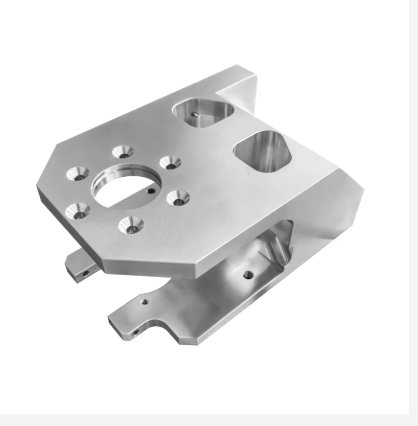CNC Machining Fundamentals: The Backbone of Precision Manufacturing
How Computer Numerical Control Transforms Production
CNC machining has revolutionized production by seamlessly integrating computer technology into manufacturing processes. Historically, CNC systems evolved from the need to improve precision and efficiency over traditional methods. These systems automate machining, allowing manufacturers to achieve higher production rates with minimal human intervention. CNC technology reduces human error significantly through precise programming and execution, paving the way for more consistent and accurate outcomes.
In comparison to traditional machining, CNC systems offer substantial time and cost savings by reducing manual labor and minimizing waste. A CNC machine's ability to produce identical parts repeatedly with high accuracy surpasses manual capabilities, leading to improved productivity and reduced operational costs. As industries continue to adopt CNC technology, their usage proliferates, with the market projected to grow rapidly. According to industry reports, the global CNC machine market is expected to reach USD 117.7 billion by 2027, driven by automotive and aerospace demands. This surge underscores the necessity and efficiency of CNC machining in contemporary manufacturing.
From CAD Models to Finished Parts: The Digital Workflow
The digital workflow in CNC manufacturing begins with CAD (Computer-Aided Design) models, which serve as blueprints for production. By leveraging these digital designs, manufacturers can ensure that every aspect of a part meets specific requirements before any physical machining occurs. CAD models transform into CNC code via CAM (Computer-Aided Manufacturing), bridging the gap between design and execution. This automated process converts design specifications into machine-readable instructions, streamlining production.
Simulation plays a crucial role in verifying these designs, enabling manufacturers to anticipate potential issues and evaluate the effectiveness of machining strategies. Through simulated runs, potential errors are identified and corrected before reaching the production phase. Quality control measures are inherently integrated into this digital workflow, ensuring consistent output quality. Several industries have experienced reduced lead times due to this efficient workflow. For instance, companies employing CNC machines for mould creation have reported up to a 30% decrease in production times, illustrating the transformative impact of digitization in manufacturing.
Precision Cutting Processes: Milling, Turning, and Beyond
CNC Metal Machine Milling Techniques
The milling process is a pivotal part of CNC machining, used extensively to shape metal and other materials by removing excess material with precision. This technique is vital for creating flat surfaces, complex contours, and intricate details on components across industries. CNC milling has evolved with different techniques, such as face milling for creating flat surfaces and contour milling for detailed work. The advancements in tooling, such as high-speed tools and advanced coatings, have significantly enhanced the efficiency and effectiveness of CNC milling, allowing for quicker production and greater precision. Modern CNC mills boast high material removal rates, enabling cost and time-efficient manufacturing processes. CNC metal machine milling is being innovatively used in various sectors, notably the automotive and aerospace industries, where precision and reliability are paramount. Here, this technique plays a critical role in ensuring component performance and durability.
Advanced Turning Operations for Complex Geometries
Turning operations are significant for fabricating cylindrical parts and are a staple within CNC machining. These operations involve rotating the workpiece while applying cutting tools to shape the material. Advanced turning capabilities, such as multi-tasking and precision control, enable the creation of complex geometries that were once difficult to achieve. CNC technology addresses challenges faced in turning by providing solutions that enhance precision and reduce error margins. When compared to conventional methods, CNC turning vastly improves accuracy, with metrics often illustrating reduced variability and enhanced product consistency. Industries like automotive and aerospace greatly benefit from precision turning operations as they require components that meet stringent standards, both in terms of structure and reliability.
Swiss Machining for Micro-Scale Components
Swiss machining is a specialized CNC process uniquely suited to manufacturing small, intricate parts with high precision. This technique uses specialized CNC lathes designed to produce detailed components by allowing simultaneous multitool processing, which helps maintain tight tolerances. Swiss CNC operations are integral to watchmaking, electronics, and medical devices, industries where precision is non-negotiable. Statistics indicate a growing demand for micro-scale components made via CNC Swiss machining as technology advances and miniaturization becomes commonplace. Looking ahead, potential trends in Swiss machining include further integration with digital technologies, increasing automation, and possibly expanded applications in emerging sectors, indicating a robust future for this specialized machining technique.
Material Considerations in High-Precision CNC Work
Optimizing CNC Brass Machining for Electrical Components
Brass is favored in electrical component manufacturing due to its excellent conductivity, corrosion resistance, and machinability. When machining brass with CNC technology, several techniques can help optimize production and reduce waste. These include using suitable cutting speeds, precise tool selection, and effective chip removal methods to prevent overheating and potential tool damage. To further enhance efficiency, implementing automation and fine-tuning operations can minimize material waste, proving crucial for cost-effective brass component manufacturing. For example, brass has been employed successfully in creating connectors that meet stringent industry standards, showcasing its adaptability. Regulatory standards such as those set by the International Electrotechnical Commission (IEC) ensure components meet specific safety and performance criteria, reinforcing the importance of precision in production.

Titanium and Aerospace Alloys: Pushing Material Limits
Titanium and its alloys are integral to the aerospace and healthcare sectors, known for their strength, lightweight properties, and exceptional resistance to corrosion. These characteristics, however, pose challenges in machining, necessitating specialized techniques like high-speed milling and coolant application to mitigate heat generation and tool wear. CNC machining is pivotal in addressing these challenges, enhancing precision and efficiency in processing these robust materials. The cost implications of working with titanium are significant due to its pricey raw material and high machinability demands. Nonetheless, performance in high-stress environments, as evidenced by research studies, validates the investment in its use. For instance, titanium components exhibit superior reliability in jet engines and medical implants, underscoring their indispensable role in critical applications.
Achieving Unmatched Accuracy in CNC Operations
Machine Calibration and Thermal Stability Controls
Precision in CNC machining largely depends on proper machine calibration and maintaining thermal stability. Calibration ensures that machines produce parts with exact measurements, thereby minimizing errors and eliminating waste. Thermal stability is equally crucial because fluctuations in temperature can affect the machining tool's dimensions, leading to inaccuracies. High-precision CNC operations must incorporate advanced thermal management systems to counteract these effects.
Tools like laser interferometers and ballbars are commonly used for precise calibration and monitoring of thermal effects. These technologies enable real-time assessment and correction, ensuring optimal machine performance. Industry standards, such as ISO and ASME guidelines, provide frameworks for calibration processes to maintain high accuracy levels consistently. Case studies from companies like aerospace firms highlight significant improvements in machining accuracy after implementing rigorous calibration protocols.
Tooling Innovations for Sub-Micron Tolerances
Sub-micron tolerances represent the pinnacle of precision machining, where even the slightest variances can impact the final product. Innovations in tooling have made it possible to achieve and measure these tolerances with remarkable accuracy. Tools designed for these applications often incorporate advanced materials and cutting-edge design elements to maintain consistency and precision.
Industry experts emphasize the critical role of tooling innovations in achieving and sustaining sub-micron levels of precision. Applications such as medical devices and aerospace components require these tight tolerances to ensure functionality and safety. The choice of tooling material also plays a decisive role in minimizing uncertainty in measurements, as certain materials can withstand the demands of high-precision machining without compromising on performance.
FAQs
What is CNC machining?
CNC machining is a manufacturing process where computers control machine tools, creating highly precise and accurate parts with minimal human intervention.
How does CNC machining differ from traditional machining?
CNC machining automates the manufacturing process, reducing manual labor and human error, resulting in higher precision and cost savings compared to traditional methods.
What are some common applications of CNC machining?
CNC machining is commonly used in industries such as aerospace, automotive, medical device manufacturing, mold making, and electronics for producing precise components and parts.
Why is calibration important in CNC machining?
Calibration ensures CNC machines produce parts with exact measurements, minimizing errors and waste, and maintaining high precision in manufacturing.
What are the advantages of 5-axis CNC machines over 3-axis machines?
5-axis CNC machines offer more flexibility and precision, allowing for complex angles and intricate features, making them ideal for sophisticated parts in sectors like aerospace and medical devices.

